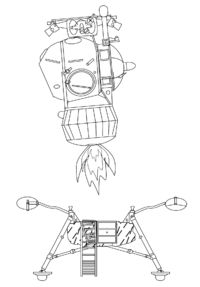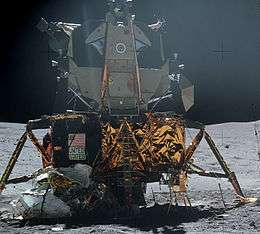LK-1
LK-1 was a projected Soviet crewed lunar flyby spacecraft. It would be launched on a three-stage Proton launch vehicle. The project started in 1962 under the lead engineer Vladimir Chelomey,[1] with the first flight planned for 1967.
| Manufacturer | OKB-52 |
|---|---|
| Country of origin | Soviet Union |
| Operator | Soviet space program |
| Applications | Carry cosmonauts around the Moon and back to Earth |
| Production | |
| Status | Canceled |
| Related spacecraft | |
| Derivatives | LK-700, TKS spacecraft |
The LK-1 had its origin in several early 1960s spacecraft projects under the generic names of kosmoplans and raketoplans.[2]
In 1965 the project was cancelled in favour of the Soyuz 7K-L1 spacecraft.[2]
Further developments came as the LK-700 direct-descent lunar lander program.
Configuration

An drawing of a VA spacecraft: The VA capsule is on the lower right, while the braking engines are located on top of the long "nose section".[3][4] The launch escape system (not shown) would have been attached on top of the nose section.[5]
The spacecraft consisted of the following modules:
- ADU Emergency Engine Unit
- VA Capsule (crew module)
- PAB Equipment-Rocket System Block (service module)
- RB Translunar Injection Stage
Characteristics
- Crew Size: 2
- Spacecraft delta v: 3,300 m/s
- Electric System: 2.00 average kW.
- Gross mass: 17,000 kg
- Un-fuelled mass: 4,000 kg
- Height: 5.20 m
- Span: 7.27 m
gollark: https://xkcd.com/2562/
gollark: Not funny, no apioforms.
gollark: I do not like it.
gollark: They're definitely... writing Rust code of some sort?
gollark: I can't tell.
External links
- Encyclopedia Astronautica:
- LK-1, with an image of an assembled translunar spacecraft
References
- https://fas.org/spp/eprint/lindroos_moon1.htm
- http://www.astronautix.com/craft/lk1.htm
- "TKS transport ship 11F72". RussianSpaceWeb.com. Archived from the original on 17 August 2012. Retrieved 30 August 2012.
- "TKS-VA (11F74)". Gunter's Space Page. Retrieved 1 September 2012.
- "TKS". Encyclopedia Astronautica. Archived from the original on 25 August 2012. Retrieved 31 August 2012.
This article is issued from Wikipedia. The text is licensed under Creative Commons - Attribution - Sharealike. Additional terms may apply for the media files.

